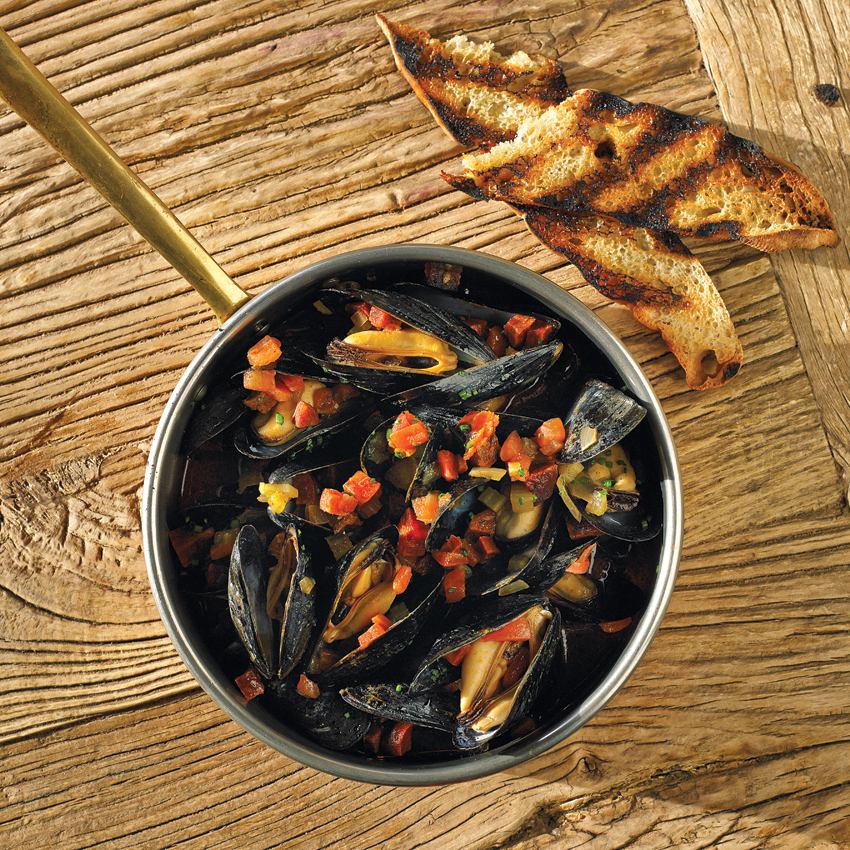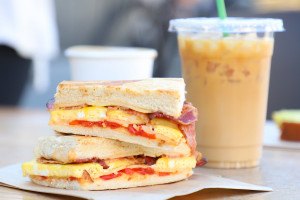Restaurant Review: Steel & Rye in Milton

Desert Island mussels with smoked tomato, chorizo, and sofrito lobster broth, $11 (Photos by Heath Robbins)
Big chefs with big reputations opening serious restaurants in the suburbs are big news. Or, at least, news. Outposts and second locations spring up, yes (mostly in malls and tony suburbs). But far-flung, ambitious kitchens where the chef cooks every night? Not so much.
Chris Parsons was one of the first to capitalize on the cost and captive-audience benefits of the ’burbs when in 2003 he opened Catch, in Winchester, and later reinvented the same space as the much-acclaimed Parsons Table, which closed in 2011. His goal then was to bring Catch to downtown Boston, but after fruitless negotiations, he split for Milton, where the leasing is easy.
In November, Parsons opened Steel & Rye, a 150-seat restaurant where the focus isn’t on seafood and the space is huge—a 7,000-square-foot former car showroom and ambulance garage. This is the happening Milton Village section, close to the Lower Mills neighborhood of Dorchester. The restaurant is ambitious, and fun, too: airy and loftlike, with big mullioned windows; rough-hewn, unfinished wood; and early-20th-century-style industrial gears and barn doors. There’s a large open kitchen and dining rooms on several levels, with many high-top tables and booths as well as traditional seating. The flow makes it all seem casual and easy, as if it had long been designed and divided this way. In scope, it’s far higher-style than the nearby 88 Wharf, and in general citification finds a suburban parallel only at Jamie Mammano’s L’Andana, that temple to Tuscany located in a cavernous former golf-supply store in Burlington. But L’Andana is a mere outpost for a chef with a slew of restaurants. Parsons mans his stove every night.
In its plain, welcoming feel (no tablecloths; red-flowered, diner-style crockery), Steel & Rye is reminiscent of Parsons’s last restaurant—which I and many city dwellers fell in love with for its unfussy, seafood-focused American menu that was secretly the product of great skill and sophistication. Parsons, who grew up fishing on Cape Cod and trained at Johnson & Wales, has an interest in cutting-edge technical feats—he even competed in the Bocuse d’Or two years ago, though he lost in eliminations. But showmanship has never been an overt part of his style. So while he’s kitted out the huge kitchen at Steel & Rye with the newest CVap steam oven, a Rational steamer/convection oven, and a massive Molteni cooking suite, he’s using the snazzy gear in mostly subtle ways, to enhance garnishes and underlying ingredients rather than disguise what he’s cooking.
I happily followed Parsons to Milton. But sadly, I found that he’s blown out his menu along with his space. There are four printed sections before you even reach the entrées. Maybe as insurance against empty tables, he’s trying for bar food, seafood, and steakhouse- and family-style fare all at the same time. Often, fairly complicated preparations don’t pay off in dishes with otherwise unified or memorable flavors. But when Parsons does focus his talents, he creates things that are so good, so at once complex and homey, that you want him to pull back, cut the menu in half, and prepare it all the same way.
Making the case for keeping things simple are dishes from the small-plates section. One comes straight off the Catch and Parsons Table menus: salt-roasted Maine clams ($11), baked and stuffed with garlicky bread crumbs featuring chewy little nuggets of air-dried chorizo. The clams were warm yet tender, a sign that Parsons still knows what he’s doing with his bounty from the deep. Further evidence was the oyster stew ($12), a creamy soup enhanced by the addition of potatoes, bacon, and house-smoked hake. Homemade chive biscuits and droplets of parsley oil elevated the dish well beyond a standard chowder. Mussels in a sofrito-based lobster broth ($11), meanwhile, were sharply saline, with an added peppery kick from chorizo. Chicken-liver crostini ($5), from the “Snacks” section, was another standout, with a butter-rich, silken texture that was more like a mousse than a rustic chopped liver. (The toasted bread alongside tasted of butane fumes, however, a problem with a number of grilled items.)

Chicken-liver crostini, $5


